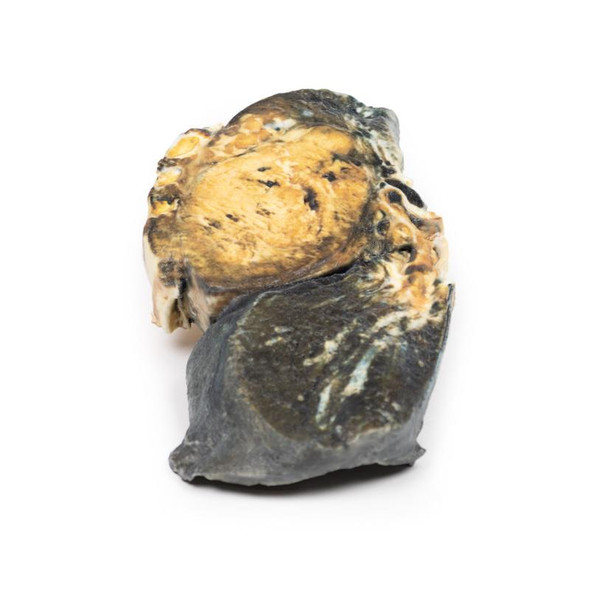Description
Clinical History
A 44-year-old man had a skin lesion on his back that grew slowly. At presentation at A&E several years later, he complained of bone pain, and had hepatomegaly and a pleural effusion. He died shortly afterwards.
Pathology
The specimen is a loop of small intestine mounted to display the mesentery, which contains numerous small dark brown, circumscribed nodules varying from pin head size to approximately 1 cm in diameter. Histology confirmed the diagnosis of metastatic melanoma.
Further Information
The most common form of melanoma is cutaneous melanoma, which develops from the pigment-producing cells known as melanocytes. In women, they most commonly occur on the legs, while in men they most commonly occur on the back. About 25% of melanomas develop from moles. Changes in a mole that can indicate melanoma include an increase in size, irregular edges, change in color, itchiness or skin ulceration.
Skin melanoma is associated with exposure to UV radiation in sunlight or tanning beds. Other risk factors for developing melanoma include fair complexion, presence of large number of melanocytic naevi (moles), severe sunburn as a child, and immunosuppression. It accounts for around 5% of all skin cancer diagnosis but has the highest mortality rate of all skin cancers. Melanomas typically occur in sun exposed areas as a pigmented lesion with irregular borders, variegated color, an asymmetrical shape and which evolves with time.
There are multiple mutations common in melanoma. Loss of cell cycle control gene from mutation in CDKN2A gene. Mutations in pro-growth signaling pathways, such as BRAF and PI3K mutations, are seen frequently in melanomas as well as mutations that activate telomerase, such as the TERT gene. Recognition that melanoma antigens activate host immune responses has led to promising immunotherapy, which enhances host T-cell identifying of these antigens.
The most common sites for metastasis of melanoma are the lungs, liver, brain and bone as well as regional lymph nodes, and is highly dependent on the site of the primary tumor. Metastatic melanoma involving the gastrointestinal tract may present with anemia, overt bleeding, pain, obstruction, or intussusception. The jejunum and ileum are the most commonly involved sites, followed by the colon, rectum, and stomach. Surgery has usually been reserved for patients with the above complications.
The probability of metastatic spread from skin melanoma depends on the stage of the primary tumor, which is based on tumor depth, mitotic activity and ulceration of the skin as well as node and solid organ involvement. Diagnosis of melanoma is made with excisional biopsy. Investigation for bone metastasis is done using blood test (raised Alkaline phosphatase, calcium and LDH), and radiological investigations most commonly X-ray and CT but MRI and PET scans may also be used. Treatment depends on the stage or the tumor as well as the genetic and immune profiles of the melanoma. Treatment usually involves surgical resection, chemotherapy, targeted therapies (e.g. BRAF inhibitors), immunotherapy , radiotherapy or more commonly a combination of treatments.
Advantages
- Anatomically accurate and identical to real specimen
- No ethical issues - not real human body parts
- Reasonably priced
- Available within a short lead time
- Reproducible, several identical prints can be used as a classroom set
- Can be produced in different sizes to cater for the needs of the teacher
Human Cadavers
- Access to cadavers can be problematic. Many countries cannot access cadavers for cultural and religious reasons
- Cadavers cost a lot money
- High cost for establishing your own plastination suite
- Wet specimens cannot be used in uncertified labs
- Dissection of cadavers is a lot of staff time and that is a cost
- Storage of cadaver material needs special refrigeration etc. which has coast
- If you want another specimen you have to start all over again
Plastinates
- Costs
- Ethical issues
- Timeframe for plastination process
- Many countries do not allow their importation
- One of a kind
Superior 3D print results compared with conventional methods
- Vibrant color offering with 10 million colors
- UV-curable inkjet printing
- High quality 3D printing that can create products that are delicate, extremely precise and incredibly realistic
Clear Support Material
- To avoid breakage of fragile, thin, and delicate arteries, veins or vessels, a clear support material is printed on such spots. This makes the models robust and can be handled by students easily.



















